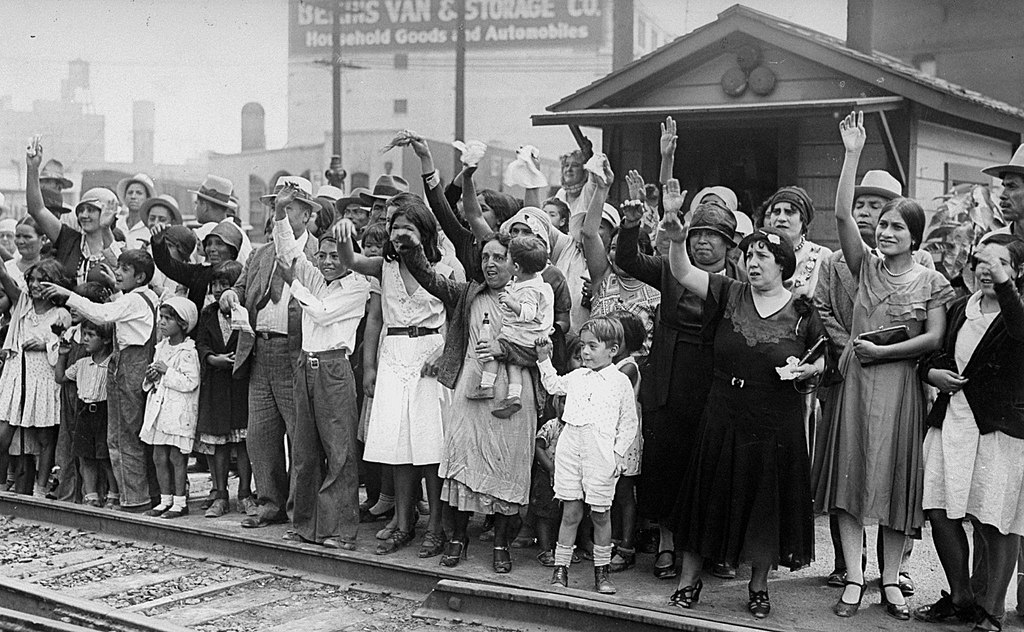I'm a biologist. Here's why I wrote about U.S. history (1929-1939)
Published in Arts & Humanities
Explore the Research

“Despedida”: My great great grandfather’s corrido about the Mexican repatriation - Latino Studies
Latino Studies -

Relatives and friends wave goodbye to a train carrying persons being expelled from Los Angeles to Mexico on August 20, 1931. Source: Wikimedia Commons.
To be sure, I grew up in the ethnically-segregated town of south Colton, where the deportation trains from Los Angeles regularly stopped to pick up families in my community. However, my grandparents, who lived through it all, did not talk about what they experienced during the Great Depression. In 2021 I learned from a family member that my great-great grandfather, who emigrated to the U.S. from Michoacán, Mexico in 1898, had been a teacher on a hacienda and had left behind some of his writings. This surprised me because like many young Latinos growing up in California, I had internalized the pathological stereotype that Mexican immigrants back then were illiterate. Not true. Many people who came to the U.S. from Mexico were fleeing violence and civil war and were consumers of daily Spanish language newspapers.
It wasn't until I started translating my ancestor's writings that I first came across the words "Mexican repatriation" in a corrido or narrative ballad he had written. Corridos were a popular form of history typically written from the perspective of the poor. (As it turns out UCLA has over 125,000 Spanish-language recordings from 1908 to the present including many corridos in The Strachwitz Frontera Collection of Mexican and Mexican American Recordings.) Historian Vicki Ruiz, who has written about this period of U.S. history in her book Out of the Shadows: Mexican American Women in Twentieth Century America encouraged me to write about my family's corrido.
Since I am an evolutionary biologist and not a historian, her first recommended reading for me was the classic book about this period of U.S. history, Francisco E. Balderrama and Raymond Rodríguez's Decade of Betrayal: Mexican Repatriation in the 1930s. Most of this book focuses on the events taking place in Los Angeles, Gary, Indiana, and Chicago. My family's experience of the Mexican repatriation took place in a town about 52 miles from Los Angeles, at the intersection of the Southern Pacific and Santa Fe railway stations. Balderrama and Rodríguez's book was key in helping me make sense of my great-great grandfather's words. The writings of historian Marla A. Ramírez, who has a forthcoming book on the topic, Banished Citizens: A History of the Mexican American Women Who Endured Repatriation, were also important to my understanding of the period. Ramírez clarified that banishment is a better word to describe what happened to most people during this period than deportation. Banishment denotes the illegal expulsion of U.S. citizens from their country of origin whereas deportation implies a formal removal of non-U.S. citizens for violation of immigration law. The archival research of historian Romeo Gúzman helped me to understand how much repatriated people tried to come back to the U.S., but were thwarted by unfair practices by government officials.
It's risky as an academic to publish outside your area of expertise. But telling the story of my family's experience of the Mexican repatriation in the 1930s seemed important, so I dropped what I was doing last summer and wrote this. It seemed clear that more than 90 years after my ancestor wrote down what he witnessed, the U.S. was on the verge of repeating history. It was through translating and researching his lyrics that I first learned that up to 60% of people forced to leave were U.S. citizens, mostly children. By reading both Spanish and English language newspaper articles of the time, I learned about the vast suffering of the poor, who were unemployed or paid subsistence wages, discriminated against and scapegoated. Many who left for Mexico did not have good fates. My ancestor seemed to want to comfort the people who were leaving for Mexico, and he wrote about them with great empathy.
I hope that this article will inspire other scholars to step outside their comfort zone and bring their own families' experiences of this period out of the shadows and into the light.
Follow the Topic
-
Latino Studies

This journal explores the local, national, transnational, and hemispheric realities that influence the Latina/x/o presence in the United States (as well as elsewhere in the diaspora).




Please sign in or register for FREE
If you are a registered user on Research Communities by Springer Nature, please sign in